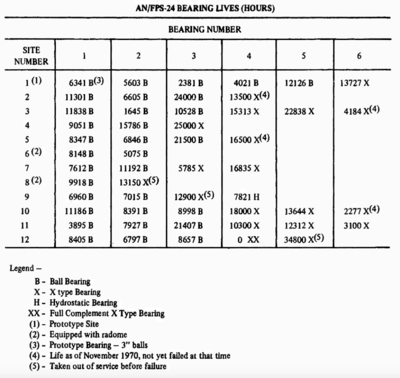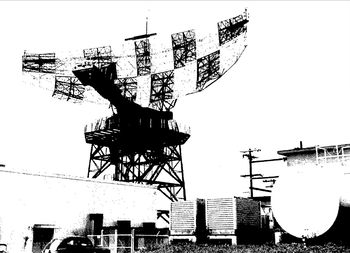FPS-24: Difference between revisions
John Stanton (talk | contribs) No edit summary |
John Stanton (talk | contribs) m Text replace - "[http://www.radomes.org" to "Bad Links " |
||
| (15 intermediate revisions by the same user not shown) | |||
| Line 1: | Line 1: | ||
{{SocialNetworks}} | {{SocialNetworks}} | ||
{{PageHeader}} | {{PageHeader}} | ||
'''{{PAGENAME}} Long range search Radar Set''' - A Long range frequency diversity search Radar set designed for select [[SAGE System]] radar sites built by General Electric. Twelve units were built for the United States Air Force between 1958 and 1962 by General Electric. | '''{{PAGENAME}} Long range search Radar Set''' - A Long-range frequency diversity search Radar set designed for select [[SAGE System]] radar sites built by General Electric. Twelve units were built for the United States Air Force between 1958 and 1962 by General Electric. | ||
{|{{FWpicframe}} | {|{{FWpicframe}} | ||
|- valign="top" | |- valign="top" | ||
|width="50%"|<!--[[Image:.jpg|300px|thumb|left|FPS-24 Search Radar]]--> | |width="50%"|<!--[[Image:.jpg|300px|thumb|left|FPS-24 Search Radar]]--> | ||
|width="50%"|<!--[[ | |width="50%"|<!--[[mage:.jpg|300px|thumb|right|FPS-24 Search Radar]]--> | ||
|- | |- | ||
|colspan="2"|[[File:Malmstrom AFB Radar Site.jpg|795px|thumb|center|Malmstrom AFB FPS-24 Radar Site (center) circa 1964-1971.]] | |colspan="2"|[[File:Malmstrom AFB Radar Site.jpg|795px|thumb|center|Malmstrom AFB FPS-24 Radar Site (center) circa 1964-1971.]] | ||
|} | |} | ||
These radar sets, like the [[FPS-35]], were installed in and on five story towers that were each capped with a 70 to 80 ton rotating antenna. Two types of towers were used, the most common was a five story concrete tower that rose 84' 6" high with a 60' 3" square footprint. This configuration was used in eight of the FPS-24 installations with the other four installations using steel framed towers. The rotating antennas were very large and only two were covered with a radome, [[Mount Hebo Air Force Station]] and [[Cottonwood Air Force Station]]. | These radar sets, like the [[FPS-35]], were installed in and on five-story towers that were each capped with a 70 to 80-ton rotating antenna. Two types of towers were used, the most common was a five-story concrete tower that rose 84' 6" high with a 60' 3" square footprint. This configuration was used in eight of the FPS-24 installations with the other four installations using steel framed towers. The rotating antennas were very large and only two were covered with a radome, [[Mount Hebo Air Force Station]] and [[Cottonwood Air Force Station]]. | ||
{{FPS-24RadarSites}} | {{FPS-24RadarSites}} | ||
[[File:FPS-24 Bearing Lives.png|thumb|left|400px|FPS-24 Bearing Lives Table.]] | [[File:FPS-24 Bearing Lives.png|thumb|left|400px|FPS-24 Bearing Lives Table.]] | ||
[[File:FPS-24.jpg|thumb|right|350px|FPS-24 on Open Steel Tower.]] | |||
{{Clr}} | {{Clr}} | ||
<blockquote>AN/FPS-24 and ÄN/FPS-35 Air Defense Radars were designed for continuous, highly reliable operation in the SAGE (Semi-Automatic Ground Environment) system. It was intended that these radars should operate 365 days a year, 23 hours a day, for ten years, one hour a day being allowed for preventive maintenance. However, it soon became apparent that this degree of reliability was not to be realized. Azimuth bearings began to fail at an average rate of once a year on each AN/FPS-24, and once every two years on each AN/FPS-35. Because this high failure rate was not anticipated, ease of replacement had not been given major consideration in the design. Consequently, bearing changes required radars to be shut down for as long as three months, with costs as high as $ 175,000 for a single bearing change. This situation was intolerable to the user, Aerospace Defense Command (ADC), and to the Air Force Logistics Command (AFLC), which was responsible for supplying replacement bearings. As a result, direction was received to take immediate action to alleviate the urgent problems of supply and replacement time and to undertake concurrently a long range program of general improvement in the large antenna bearing area. | The initial installations of the FPS-24 revealed many problems that caused a delay in operational status. The problems were resolved and the radar was operational in 1962. The antenna system provided another set of operational problems mostly due to failures of the bearing that the 85.5-ton antenna rotated upon. Catastrophic bearing failures sometimes caused secondary damage to the support towers, sails, and feed horns. Some sites were actually closed due to catastrophic failure of the antenna system and others were forced to install other search radar sets when the damage could not be repaired. At [[Mount Hebo Air Force Station]] fears that the high winds would damage the FPS-24 antenna led to three attempts to enclose it in a radome. All three radomes were destroyed by the high winds and the last radome failure also damaged the antenna sail. The FPS-24 was removed and replaced with a [[FPS-27]]. | ||
{{Clr}} | |||
From the RADC-TR-71-81 Technical Report December 1971, Bearing Improvement Program For Large Rolling Element Bearings: | |||
<blockquote>AN/FPS-24 and ÄN/FPS-35 Air Defense Radars were designed for continuous, highly reliable operation in the SAGE (Semi-Automatic Ground Environment) system. It was intended that these radars should operate 365 days a year, 23 hours a day, for ten years, one hour a day being allowed for preventive maintenance. However, it soon became apparent that this degree of reliability was not to be realized. Azimuth bearings began to fail at an average rate of once a year on each AN/FPS-24, and once every two years on each AN/FPS-35. Because this high failure rate was not anticipated, ease of replacement had not been given major consideration in the design. Consequently, bearing changes required radars to be shut down for as long as three months, with costs as high as $ 175,000 for a single bearing change. This situation was intolerable to the user, Aerospace Defense Command (ADC), and to the Air Force Logistics Command (AFLC), which was responsible for supplying replacement bearings. As a result, direction was received to take immediate action to alleviate the urgent problems of supply and replacement time and to undertake concurrently a long-range program of general improvement in the large antenna bearing area. | |||
RADC-TR-71-81 Technical Report December 1971, Bearing Improvement Program For Large Rolling Element Bearings, [http://www.dtic.mil/dtic/tr/fulltext/u2/891286.pdf Pdf]</blockquote> | RADC-TR-71-81 Technical Report December 1971, Bearing Improvement Program For Large Rolling Element Bearings, [http://www.dtic.mil/dtic/tr/fulltext/u2/891286.pdf Pdf]</blockquote> | ||
The cure for the bearing problem was the development of a hydrostatic bearing for the AN/FPS-24 by Goodyear Aerospace Corp. The prototype was tested at Oakdale Air Force Station. | The cure for the bearing problem was the development of a hydrostatic bearing for the AN/FPS-24 by Goodyear Aerospace Corp. The prototype was tested at [[Oakdale Air Force Station]]. The test was terminated after 7821 hours with a catastrophic failure caused by human error. That bearing is shown on the chart above in line 9. That FPS-24 was not supplied with another bearing and it shut down in 1969. No other sites had received the hydrostatic bearings as of the date of this report (1970) and some 40 bearings had been replaced. | ||
{{Clr}} | {{Clr}} | ||
== Current Status == | == Current Status == | ||
| Line 26: | Line 30: | ||
{| width="800px" | {| width="800px" | ||
|- | |- | ||
| width="50%" | | | width="50%" valign="top" | | ||
{| class="wikitable" width="400px" | {| class="wikitable" width="400px" | ||
|+ FPS-24 Search Radar | |+ FPS-24 Search Radar | ||
| Line 50: | Line 54: | ||
| Frequency || 214 to 236 MHz || | | Frequency || 214 to 236 MHz || | ||
|- | |- | ||
| PRF || || | | PRF || 278 || | ||
|- | |- | ||
| Pulse Width || 20 us || | | Pulse Width || 20 us || | ||
| Line 56: | Line 60: | ||
| Power || 7.5 mw max<br>5 mw normal|| | | Power || 7.5 mw max<br>5 mw normal|| | ||
|- | |- | ||
| Range || || Long range | | Range || 250 nmi|| Long range | ||
|- | |- | ||
| Altitude || || | | Altitude || || | ||
| Line 78: | Line 82: | ||
| Ball Diameter || 3.5" || | | Ball Diameter || 3.5" || | ||
|- | |- | ||
| Roller Diameter || 2.68" | | Roller Diameter || 2.68" || | ||
|- | |- | ||
| Introduced || 1961 || | | Introduced || 1961 || | ||
|} | |} | ||
| width="50%" | | | width="50%" valign="top" | | ||
[[File:Blaine AFS FPS-24 Tower.jpg|thumb|left|350px|Blaine AFS Concrete FPS-24 Tower.]] | |||
[[File:Cottonwood AFS Steel Tower.jpg|thumb|left|350px|Cottonwood AFS Enclosed Steel FPS-24 Tower.]] | |||
|} | |} | ||
<!--[[File:fffff System.png|thumb|center|800px|FPS-3 System Components]]--> | <!--[[File:fffff System.png|thumb|center|800px|FPS-3 System Components]]--> | ||
| Line 93: | Line 98: | ||
* [[FPS-35]] | * [[FPS-35]] | ||
* [[US Radar Sets]] | * [[US Radar Sets]] | ||
* [[Permanent System Radar Sites]] | |||
'''Sources:''' | '''Sources:''' | ||
* {{Winkler}} | * {{Winkler}} | ||
* | * RADC-TR-71-81 Technical Report December 1971, Bearing Improvement Program For Large Rolling Element Bearings, [http://www.dtic.mil/dtic/tr/fulltext/u2/891286.pdf Pdf] | ||
'''Links:''' | '''Links:''' | ||
* [ | * [[Bad Links]] /museum/equip/radarequip.php?link=fps-24.html Radar Equipment] | ||
* [https://en.wikipedia.org/wiki/AN/FPS-24_Radar Wikipedia - FPS-24] | * [https://en.wikipedia.org/wiki/AN/FPS-24_Radar Wikipedia - FPS-24] | ||
* [http://hubpages.com/education/Cold-War-Era-A-Bit-of-History Hub Pages - FPS-24 Radar] | |||
__NOTOC__ | __NOTOC__ | ||
{{PageFooter}} | {{PageFooter}} | ||
[[Category:Radar Sets]] | [[Category:Radar Sets]] | ||
[[Category:FPS-24]] | |||
Latest revision as of 07:56, 29 May 2020
|
FPS-24 Long range search Radar Set - A Long-range frequency diversity search Radar set designed for select SAGE System radar sites built by General Electric. Twelve units were built for the United States Air Force between 1958 and 1962 by General Electric.
These radar sets, like the FPS-35, were installed in and on five-story towers that were each capped with a 70 to 80-ton rotating antenna. Two types of towers were used, the most common was a five-story concrete tower that rose 84' 6" high with a 60' 3" square footprint. This configuration was used in eight of the FPS-24 installations with the other four installations using steel framed towers. The rotating antennas were very large and only two were covered with a radome, Mount Hebo Air Force Station and Cottonwood Air Force Station.
 
From the RADC-TR-71-81 Technical Report December 1971, Bearing Improvement Program For Large Rolling Element Bearings:
The cure for the bearing problem was the development of a hydrostatic bearing for the AN/FPS-24 by Goodyear Aerospace Corp. The prototype was tested at Oakdale Air Force Station. The test was terminated after 7821 hours with a catastrophic failure caused by human error. That bearing is shown on the chart above in line 9. That FPS-24 was not supplied with another bearing and it shut down in 1969. No other sites had received the hydrostatic bearings as of the date of this report (1970) and some 40 bearings had been replaced.
Current StatusAll of the radar sets have now been dismantled and removed from the buildings and although many of the towers remain there are no antennas still installed.
FPS-24 Search Radar
Sources:
Links:
| |||||||||||||||||||||||||||||||||||||||||||||||||||||||||||||||||||||||||||||||||||||||||||||||||||||||||||||||||||||||||||||||||||||||||||||||||||


